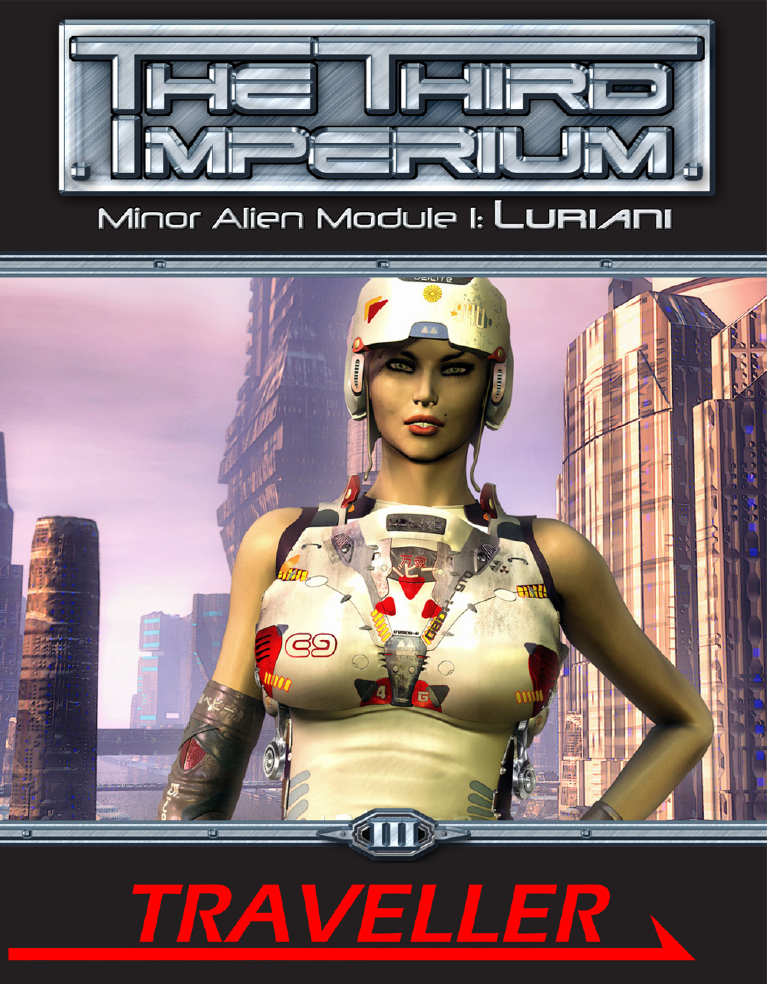The Third Imperium: Minor Alien Module 1: Luriani
This article appeared in the February 2013 issue of the magazine.
 The
Third Imperium: Minor Alien Module 1: Luriani. Andrea Vallance.
The
Third Imperium: Minor Alien Module 1: Luriani. Andrea Vallance.
Mongoose Publishing http://www.mongoosepublishing.com
60pp., PDF
US$19.99/UKú12.66
For the first time ever, a minor race gets in-depth treatment almost worthy of a major one.
Minor disclaimer: I am named under Special Thanks on the title page; Andrew and I had a discussion on what turned out to be core ideas concerning Luriani reproductive genetics and interbreeding with non-Luriani humans.
On the Shelf
This product is not yet available in a print edition, so you won’t see it on a shelf. At only 60 pages, it would be a slim volume, but not disappointingly so; there are third-party supplements that are thinner.
The cover follows the pattern of the other Third Imperium books, with the usual embossed-steel Third Imperium masthead right above the book title, a full-width central artwork panel, and the Traveller logo below the artwork. For this book, the artwork us a human/humanoid female against a backdrop of a futuristic city. Sadly, there are details that suggest that this was ‘stock sci-fi art’, rather than being commissioned specifically for this work.
Initial Impressions
The material is well organized: The Introduction could stand on its own as a Contact! article from the original Journal of the Travellers’ Aid Society, but here it only whets your appetite for what follows, which is a ‘day tour’ of Luriani society. This leads into an overview of their history, which seems to emphasize the stresses existing between the Luriani and the Imperium and its predecessors.
A chapter on Luriani characters follows, outlining the differences between standard Imperial human characters and Luriani. Two Luriani-specific careers are included.
A chapter on Luriani Equipment and Technology might seem out of place, given that the Luriani are part of the Imperium, but the author has included this for good reason, and a thorough reading will reveal that the Luriani are in fact far more important to the Imperium than the status of ‘minor’ race would seem to imply. One might think similarly of the chapter on Luriani Ships, and one would be equally wrong to do so, for much the same reason. You also get deckplans and stat sheets for two starships and a fighter.
The chapter on Luriani Encounters starts with a brief discussion of the Luriani temper, and how to play it; the remainder is a set of brief profiles of selected prominent Luriani, and some potential patrons/seeds for Luriani-related adventures.
Finally, there is a chapter on Luriani Worlds; this does not, as you might think, present world-generation information; rather, it is an overview of one of the subsectors of the Luriani Protectorate/Luriani Cultural Region.
Internal artwork is sparse, and all in the same style. There are details that suggest that the artist actually read some of the material she was illustrating, but in some ways, the drawings do not 'line up' with the image I formed from the text—for the most part, the people portrayed look slimmer to me than the text would suggest.
On Closer Inspection
There are a few organizational infelicities; for example, I might have taken the discussion of Luriani reproductive genetics out of the Physiology section and put it in with Interfertility with Other Humans, or with the reproduction-related sections of the Luriani Equipment and Technology chapter. For the most part, though, such infelicities are at the level of nit-picking, and in most cases, one can argue in favor of the author’s presentation just as easily as against.
Each chapter starts with an excerpt from the journal of Sara Maval Dame, giving a quick vignette of living among the Luriani. The vignettes all relate interactions between Sara and her Luriani friend and guide, Seshko, and illustrate how different Luriani social interactions can be from the “Imperial norm”. Frustratingly, there isn’t any real expansion on the vignettes; they’re presented, and you get one or two sentences—Sara’s analysis, in a sense—but that’s it, and you end up wanting more details, which searching through the book won’t turn up. They are also slightly confusing, as they often seem not to relate to the material in the chapter. One can hope that there will be a supplement to this supplement, filling in the gaps...
Many aspects of Luriani culture are covered, and not all of them are necessary for players to know for adventuring—but all contribute to understanding the Luriani, and giving them the three-dimensional feel that they have, rather than leaving them as ‘cardboard cutouts’. One would be well-served to read through the book before attempting to use it; it is very much not a mere reference.
Conclusion
The presentation of the Luriani here is at least as good as the presentation of the major races in GDW’s original Alien Modules, and sets a high bar for a minimum standard for future Minor Alien Modules. They have been made accessible as player-characters for even inexperienced players, and it seems like a campaign with the Luriani could be more fun than a “straight Imperial” campaign. This module is worth every penny of its price, and is a recommended purchase for anyone who wants to go beyond the basic rulebooks.
 Freelance
Traveller
Freelance
Traveller